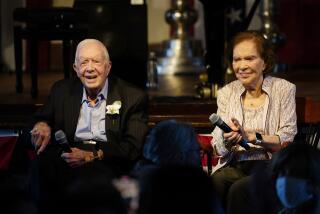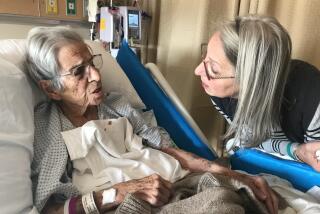Life on her terms
- Share via
FOR the last couple of years, Vailia Dennis, 87, has wondered if there existed, on the face of the earth, even one other human being who thought as she did about death. Then she read about Art Buchwald, the newspaper columnist who died at the age of 81 on Jan. 18, nearly a year after he opted out of further medical treatment, preferring to put himself in the hands of fate.
At last, Dennis thought. A soul mate. “I read about Art Buchwald and I discovered that we were like blood-related creatures,” she says. Buchwald refused kidney dialysis. He went on to outlive doctors’ predictions by almost a year, time he spent holding court with the fabulous, the famous and the powerful, and by all accounts, having a great time.
Dennis refused open-heart surgery, enrolled in care at the San Diego Hospice & Palliative Care and, within the familiarity of her San Diego home, has outlived predictions of her demise so far by two years. “This has been the most comfortable, the most interesting, time of my life,” she says.
Dennis doesn’t run into a lot of people who understand her decision to say “No, thank you,” to medical intervention, but those who do are out there -- more of them, it seems, each year. About 1.2 million patients, 80% of them older than 65, received hospice services in 2005, an increase of 150,000 from the year before and up from 210,000 in 1990, according to the National Hospice and Palliative Care Organization.
Certainly, not all of them are rejecting further treatment. Many have simply exhausted all that medicine has to offer. But end-of-life experts say there are hints in the numbers that point to a trend toward more people being willing to call a halt to aggressive treatment. The average length of service to a hospice patient has increased from 48 days in 2000 to 59 days in 2004, suggesting that people are coming to the services sooner in the course of their diseases.
“The decision that Art Buchwald made is actually not so unusual,” says Dr. David Casarett, professor and geriatrics researcher at the University of Pennsylvania and chairman of the American Geriatrics Society’s ethics committee. “A lot of people decide that the burdens of continued treatment outweigh the benefits. They don’t want to go through another hospitalization or another surgery.”
Or they don’t want another grueling round of chemotherapy with no chance of cure and very low odds of improvement, or a second or third heart transplant. An increasing number of elderly people have been sick for a long time and have gone through the medical wringer long enough to know when they want to say “Enough is enough.” “In fact, I would spin it around,” Casarett says. “There are still a few people out there who want aggressive treatment all the way to the end. But I would go out on a limb and say the majority of people don’t want that.”
They prefer a graceful exit on their own terms. “Art Buchwald is a perfect example. He lived for months with a good quality of life,” says Diane Meier, director of the Center to Advance Palliative Care at Mount Sinai School of Medicine in New York. “He said, ‘I’m not going to play,’ and lo and behold, nothing bad happened. He didn’t get caught up in grasping at all straws, and he didn’t spend his last days tethered to a machine.”
It’s a decision that can be difficult for loved ones to accept. Maybe a parent is ready to let nature take its course but children resist, or siblings disagree, or a spouse cannot let go. Sometimes it’s the medical establishment that won’t give up the fight. “In our culture, we have a unique, almost religious, faith in medical technology,” Meier says.
But watching a relative suffer through the final, ultimately futile, throes of medical heroics can diminish that faith in technology. Dennis was her brother’s caretaker after his second of two open-heart surgeries. She watched him deteriorate, bed-bound and mentally unaware during his final months. She’d seen enough to say “no” when doctors told her she needed open-heart surgery for her hypertrophic cardiomyopathy, a condition that causes a thickened wall inside the heart.
“I flatly didn’t want to go through that,” she says. “I know the stresses you go through just trying to recover enough to walk. I didn’t know if I would come out of it being who I am now, with the same independence, the same determination, the same ability to laugh. I thought it could take away a part of me that I didn’t want to give up.”
She and Buchwald both outlived medicine’s predictions for them, but that is not uncommon. A much misunderstood aspect of hospice care, says Dr. Charles von Gunten, vice president of San Diego Hospice & Palliative Care, is that they kick you out of the program if you live past a certain point.
To get Medicare or insurance coverage for hospice, a patient needs a prognosis of six months or less. “That means six months if the disease runs its normal course. It’s an average,” Von Gunten says. “There are plenty of people enrolled in hospice care for years.”
But for coverage to continue, people have to show signs of getting worse, not better. Those Medicare regulations attached to hospice coverage can disrupt end-of-life care and send a patient from one group of providers to another. (Although hospice coverage ends, Medicare continues coverage of other medical expenses.) Experts call it the hospice “failure to die” problem. If a patient stabilizes in hospice care, Medicare coverage for the program stops within a few months, says Joanne Lynn, of the Office of Clinical Standards and Quality at the Centers for Medicare & Medicaid Services.
“It can be a major disruption,” she says. It means leaving nurses, aides and other providers that patients have come to know as they go back and forth between traditional medical care and hospice care, depending on how accurately physicians have predicted their decline. It’s why Buchwald cracked, in a March 7, 2006, column: “I’ve gotten so well Medicare won’t pay for me anymore.”
About 18% of hospices offer inpatient care, either in free-standing hospice facilities or within hospitals. But most hospice patients are cared for in the place they call home -- private residences or nursing homes. Buchwald, for example, began hospice in a residential facility but later moved to a wing in his son’s home.
Patients in hospice care live longer than patients with similar conditions who are not in hospice care, according to a September 2004 study in the Journal of Pain and Symptom Management. Researchers studied 8,700 Medicare patients with 16 different terminal conditions and compared those who went to hospice care with those who did not. Researchers compared the patients’ longevity and found that for all conditions, patients in hospice lived longer by days to months.
And for most conditions, the study found, the cost of care was lower for patients in hospice. Those with congestive heart failure, one of Dennis’ health problems, lived nearly two months longer in hospice care, and the cost of their care was less by almost $9,000.
That kind of cost savings will be increasingly important as the the baby boom generation gets older and sicker. Though healthcare costs overall average $7,365 a year for Americans, the costs during the last year of life for those 65 and older skyrocket to $37,581, according to a study of Medicare spending in the December 2002 issue of the journal Health Services Research. The cost of the last year of life for all Americans, the study found, accounts for 22% of the nation’s annual healthcare bill.
Getting a little more time for a little less money was not what drove Dennis’ decision. And though she wanted no more aggressive medical intervention, she did want care-- psychological, spiritual and medical for such things as pain and symptom management.
“I’m living in my own home, by myself. I could not be doing this without hospice,” she says. “My fears are minimal, but when I’m not doing well, there’s someone I can call. A nurse visits me weekly, more if I need it. The chaplain comes once a week because we enjoy talking to each other. A woman comes three times a week to help me shower. And a social worker is available for anything I need.”
She has used her bonus years to spend time with her children and grandchildren and to paint, read and write. As an octogenarian, she has fearlessly plunged into learning what computers can do, setting up a website and blog. “I’m free,” she says. “I eat when I want to eat. I’m adept at the Internet, so I can look up whatever I want to learn.”
Like Art Buchwald, she is showing that there can be a quality-of-life advantage to giving up medical treatment when medicine’s promises diminish and fade. J. Donald Schumacher, president of the National Hospice and Palliative Care Organization, visited Buchwald during the writer’s last year, witnessing one of the magical moments Buchwald so loved so much. “When I walked in, Lauren Bacall was on the phone,” Schumacher says. “She was calling from London.”






